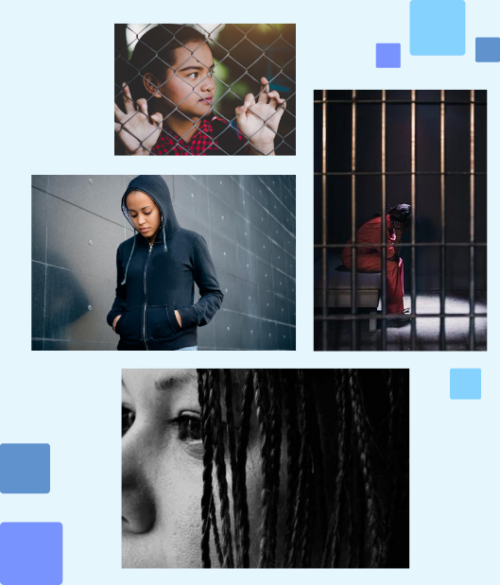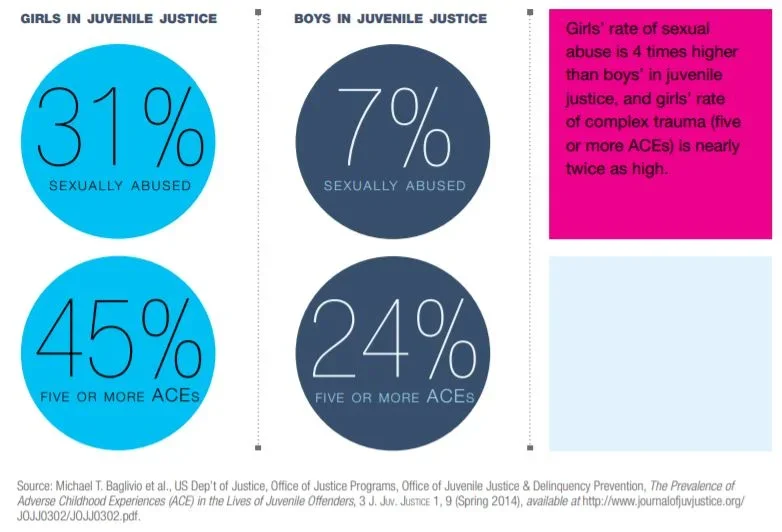
Sexual Abuse to Prison Pipeline: The Girls’ Story
February 2015
This report exposes the ways in which we criminalize girls — especially girls of color — who have been sexually and physically abused, and it offers policy recommendations to dismantle the abuse to prison pipeline. It illustrates the pipeline with examples, including the detention of girls who are victims of sex trafficking, girls who run away or become truant because of abuse they experience, and girls who cross into juvenile justice from the child welfare system.
DOWNLOAD THE SEXUAL ABUSE TO PRISON PIPELINE: THE GIRLS’ STORY or read more below.
Violence against girls is a painfully American tale. It is a crisis of national proportions that cuts across every divide of race, class, and ethnicity. The facts are staggering: one in four American girls will experience some form of sexual violence by the age of 18. Fifteen percent of sexual assault and rape victims are under the age of 12; nearly half of all female rape survivors were victimized before the age of 18. And girls between the ages of 16 and 19 are four times more likely than the general population to be victims of rape, attempted rape, or sexual assault.
And in a perverse twist of justice, many girls who experience sexual abuse are routed into the juvenile justice system because of their victimization. Indeed, sexual abuse is one of the primary predictors of girls’ entry into the juvenile justice system. A particularly glaring example is when girls who are 5 victims of sex trafficking are arrested on prostitution charges — punished as perpetrators rather than served and supported as victims and survivors.
Once inside, girls encounter a system that is often ill-equipped to identify and treat the violence and trauma that lie at the root of victimized girls’ arrests. More harmful still is the significant risk that the punitive environment will re-trigger girls’ trauma and even subject them to new incidents of sexual victimization, which can exponentially compound the profound harms inflicted by the original abuse.

This is the girls’ sexual abuse to prison pipeline.
This report exposes the ways in which we criminalize girls — especially girls of color — who have been sexually and physically abused, and it offers policy recommendations to dismantle the abuse to prison pipeline. It illustrates the pipeline with examples, including the detention of girls who are victims of sex trafficking, girls who run away or become truant because of abuse they experience, and girls who cross into juvenile justice from the child welfare system. By illuminating both the problem and potential solutions, we hope to make the first step toward ending the cycle of victimization-to-imprisonment for marginalized girls.

KEY FINDINGS FROM THE GIRLS’ PATH OF SEXUAL ABUSE INTO THE JUVENILE JUSTICE SYSTEM INCLUDE:
- The proportion of girls — especially girls of color — in the juvenile justice system is increasing.
- Girls in the juvenile justice system are disproportionately victims of sexual violence.
- Girls’ behavioral reaction to sexual abuse and trauma is criminalized, reinforcing the sexual abuse to prison pipeline.
- The juvenile justice system typically fails to address, and often exacerbates, trauma that caused girls to be there.
POLICY RECOMMENDATIONS TO REDUCE TRAUMATIZED GIRLS’ ARREST AND INCARCERATION
- Strengthen the Juvenile Justice and Delinquency Prevention Act (JJDPA)
- Further the Work of OJJDP’s National Girls Initiative
- Fully Enforce — and Strengthen — the Prison Rape Elimination Act
- Provide Gender-Specific Physical and Mental Health Care In Justice Settings
- Implement Gender-Specific Health Screening and Assessment
- Require Facilities to be Accredited for the Provision of Medical Care
- Provide Comprehensive Reproductive Health Care
- Include Trauma-Related Health Treatment in Re-entry/Aftercare Plans



